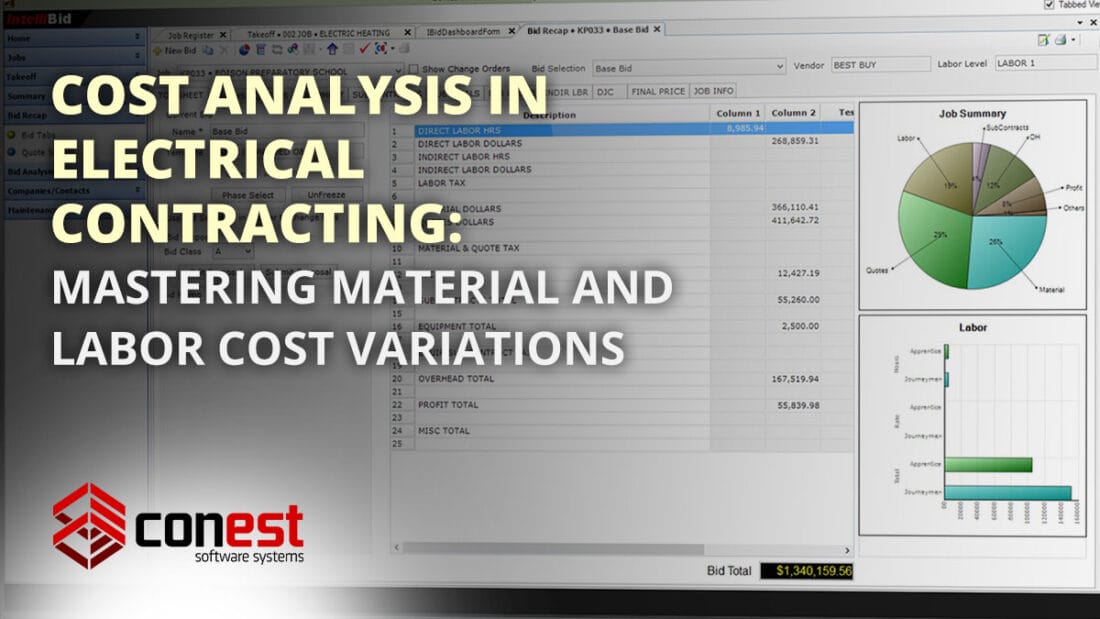Cost Analysis in Electrical Contracting: Mastering Material and Labor Cost Variations
In the intricate realm of electrical contracting, mastering the art of precise cost analysis is paramount for securing profitability, ensuring competitive edge, and guaranteeing the overall success of any project. The financial viability of electrical projects hinges significantly on the ability to navigate and manage the fluctuations in material and labor costs effectively. This detailed exploration offers insights into the nuances of understanding and adeptly handling these cost variations, incorporating considerations of the National Electrical Code (NEC) and industry best practices.
Understanding Material Cost Variations
Market Fluctuations
Material costs in the electrical contracting sector are subject to volatility due to a myriad of market conditions, including shifts in the prices of raw materials, alterations in transportation costs, and the ever-changing dynamics of supply and demand. To mitigate the impact of these fluctuations, estimators must remain vigilant, constantly updating their knowledge on market trends to forecast and accommodate potential price adjustments. Familiarity with the NEC can also guide estimators in choosing compliant materials that are both cost-effective and meet safety standards.
Vendor Relationships
Cultivating robust relationships with suppliers is instrumental in gaining insights into forthcoming price trends and possibly securing more advantageous pricing terms. This strategy involves consistent engagement with vendors to remain abreast of market developments and to leverage these relationships for better pricing and terms. Ensuring that materials meet NEC standards for safety and compatibility while negotiating prices can further enhance project outcomes.
Alternative Materials
Exploring alternative materials that fulfill the same requirements at a reduced cost or with improved availability can lead to substantial savings. Nevertheless, it’s critical to verify that these substitutes not only comply with the project’s specifications but also adhere to NEC guidelines, ensuring they do not compromise on safety or functionality.
Navigating Labor Cost Variations
Skill Level and Availability
The cost of labor is significantly influenced by the required skill level and the availability of qualified workers. Regions experiencing a scarcity of skilled labor may face higher costs. An in-depth understanding of the local labor market, coupled with strategic planning to align project needs with available skills, is essential for accurate cost forecasting.
Union vs. Non-Union Labor
The decision between employing unionized or non-union labor can greatly affect project labor costs. While union labor may be associated with higher wages and benefits, it often brings a level of experience and training that can enhance project execution. Estimators must evaluate these aspects in light of the specific project demands, considering the potential for higher efficiency and reduced errors that come with skilled labor.
Overtime and Scheduling
The necessity for overtime work or adherence to stringent deadlines can escalate labor costs. Implementing effective project scheduling and labor management practices is vital to curtail unnecessary overtime charges, optimizing the balance between project timelines and labor expenses.
Analyzing Project-Specific Factors
Complexity and Scale
The intricacies and magnitude of a project directly influence both material and labor costs. Projects of larger scale or higher complexity often necessitate specialized materials or highly skilled labor, leading to increased costs. Estimators must account for these variables, employing thorough analysis and planning to ensure accurate cost estimations.
Location and Logistics
A project’s geographical location plays a critical role in determining both material and labor costs. Projects situated in remote or challenging locations may incur additional costs for material transportation and may require higher compensation for workers due to travel demands.
Regulatory and Environmental Factors
Adherence to local regulations, including compliance with the NEC, and environmental standards can also impact the costs associated with materials and labor. Opting for environmentally sustainable materials or meeting stringent regulatory requirements might elevate project costs, necessitating careful planning and client consultation.
Strategies for Effective Cost Management
Continuous Market Research
Maintaining an up-to-date understanding of material and labor market trends is crucial for informed decision-making and cost prediction. Regular engagement in market research facilitates the anticipation of cost fluctuations and aids in strategic planning.
Flexible Estimating
Adapting a flexible approach to estimating that accommodates market variability is key. This involves the ongoing refinement of cost databases with the latest pricing information and allowing for adjustments in project estimations as new data becomes available.
Contingency Planning
Incorporating a contingency budget within project estimates provides a safeguard against unexpected cost escalations, ensuring that unforeseen expenses do not compromise project profitability.
Client Communication
Fostering transparent communication with clients regarding cost variations is essential for managing expectations and sustaining trust. Clear explanations of cost adjustments and their underlying reasons can help in mitigating client concerns and maintaining project integrity.
Conclusion
Cost analysis in electrical contracting demands a sophisticated understanding and strategic management of material and labor cost variations. By staying informed of market trends, nurturing vendor relationships, comprehending project-specific factors, and implementing effective cost management strategies, electrical contractors can adeptly navigate these complexities, ensuring accurate project estimations and the financial success of their endeavors.


